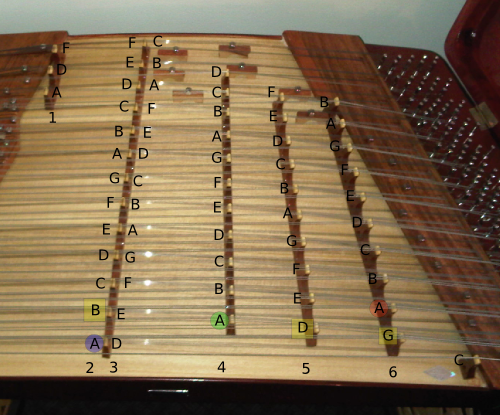How To Tune a Yangqin
Saturday 15 January 2011 - Filed under Default
A number of years ago I purchased a Yangqin (pronounced yawng-tseen) for a relative but never saw it properly tuned. Today I learned a method for tuning and since I couldn’t find this anywhere I am going to document the process here. If you have any comments, I’d love to hear what I may improve so others can enjoy this beautiful instrument.
There a number of different layouts for the instrument depending on where the instrument is made and what kind of music will be played on it. I am documenting here the layout for one that was purchased in Suzhou “the Venice of the east”, China (near Shanghai) in 2004.
First a bit about the instrument: The yangqin is a Chinese percussion instrument with many sets of strings that are either plucked or hit with special mallets. Individual notes are produced by groups of 1 to 5 strings that follow closely parallel paths and are tuned to the same note, similar to a piano’s strings. The tuning of each note(again made by from 1 to 5 strings) is combination of two mechanical settings.
First is the tension which is set using a tuning wrench to turn pegs on the right side of the instrument. The second is the position of small metal cylinders that simultaneously change the length of the vibrating section and the tension on the string.
The strategy I would follow to tune this instrument is first to set all the metal cylinders to the center of their range of motion. This will allow for simple minor adjustments due to environmental changes. Then each individual string should be plucked and tuned with the big tuning wrench using a chromatic tuner(just like one would use for a guitar or other instrument).
Update: There are many tuner apps available for phones and tablets.
There are many strings on this instrument so this process may take minutes to hours and may involve multiple passes over the intstrument, fine tuning of individual notes, or some combination of the two. Your ears will be invaluable here.
The picture below shows the note that should be produced by hitting each position on the instrument. If a position doesn’t have a note, that means it’s not supposed to be played. When in doubt if the strings go from a white bridge piece to a metal cylinder it can be played.
The tuning described here has all notes in the key of C (no sharps or flats) and the tuning goes from low on the side closest to you to high further away from you.
Using A as an example, the blue A (2) is one octave below the green A (4) which is one octave below the red A (6). So by playing the blue, green, and red A’s in sequence you hear three octaves of A ring together.
Note that the only set of bridges for which strings can be struck on either side is the longest column shown as columns 2 and 3.
Another octave relationship exists between columns 3 and 5 with the two Ds on the bottom being one octave apart. The yellow D is one octave higher than the uncolored one.
The last relationship required to figure this out (and I’m not really sure how column 1 fits into this) is going from right to left with the yellow squares and green A. This is best explained with a note line (like a number line).
If I start with the green A in the tuning chart, I should move down melodically four notes in the C-major scale to get the yellow D at the bottom of column 5. Then I should continue 4 notes lower in the C-major scale to get the yellow G at the bottom of column 6. Going the other direction from the green A, notes E and B in columns 3 and 2 respectively are 4 notes each up on the C-major scale.
I’m not sure that everyone will spell this instrument the same way in English so here are some other words that might be used to spell it to help those in need find this howto. yong, yang, chin, qin, tsien, chien, yongtsien, yongqin, yongchin, yongchien, yangtsien, yangqin, yangchin, yangchien. Yes, I’m aware search engines do this kind of translation already but I have no idea how that works for westernized Chinese syllables.
2011-01-15 » David Sterry

